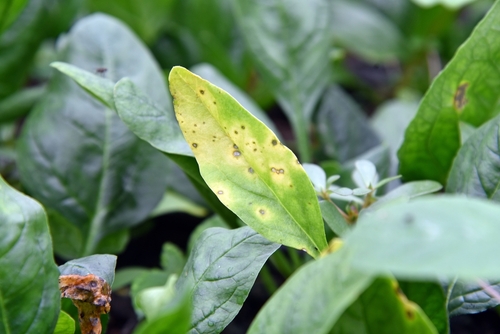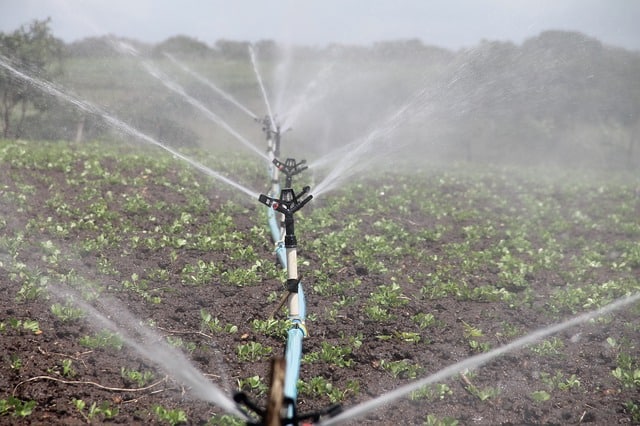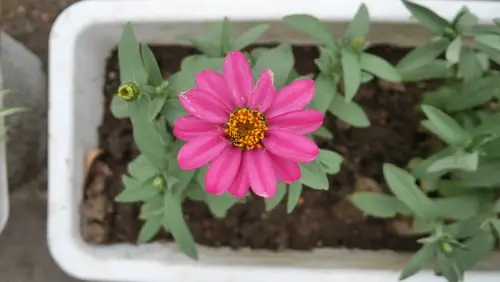White spots on zinnia leaves can be a sign of a fungal disease known as powdery mildew. This common disease may not cause significant damage to the zinnia plant, but it can detract from its appearance.
Fungal spores are spread from one plant to another by wind or splashing water, so it’s important to take steps to prevent and treat powdery mildew. There are several other causes of white spots on zinnia leaves, including bacterial leaf spot and Alternaria blight.
These diseases can cause more severe damage to the plant, including brown and dry leaves and severely affected blossoms. Understanding the symptoms and damage caused by these diseases is essential for effective prevention and treatment.
Environmental factors such as warm, wet, or humid weather can also play a role in the development of white spots on zinnia leaves. Proper plant care and prevention strategies, such as avoiding overhead watering and providing adequate air circulation, can help reduce the risk of fungal diseases.
In this article, we will explore the common causes of white spots on zinnia leaves, symptoms and damage, prevention strategies, and treatment options.
Key Takeaways
- White spots on zinnia leaves can be caused by fungal diseases like powdery mildew, bacterial leaf spot, and Alternaria blight.
- Environmental factors like warm, wet, or humid weather can contribute to the development of white spots on zinnia leaves.
- Proper plant care and prevention strategies, including avoiding overhead watering and providing adequate air circulation, can help reduce the risk of fungal diseases.
Also don’t miss:
Understanding White Spots on Zinnia Leaves

Zinnias are beautiful and colorful flowers that can brighten up any garden or landscape. However, sometimes they can be plagued by white spots on their leaves, which can detract from their appearance. These white spots are usually caused by a fungal disease called powdery mildew.
Powdery mildew is a common fungal disease that can affect a wide variety of plants, including zinnias. It appears as white or grayish spots on the leaves, stems, and flowers of the plant. The fungus thrives in cool, moist conditions and can spread quickly, especially in crowded or humid environments.
The white spots on zinnia leaves are caused by the powdery mildew fungus spores that are spread by wind or splashing water. The disease can cause the leaves to become distorted, stunted, and eventually die. However, powdery mildew does very little damage to the plant’s overall health, and it is mainly an aesthetic issue.
To prevent and treat powdery mildew on zinnias, it is essential to keep the plant’s leaves dry and avoid overhead watering. Watering at the base of the plant or using a drip irrigation system can help prevent the leaves from becoming too wet.
It is also important to ensure proper air circulation around the plant by thinning out crowded areas and avoiding planting zinnias too close together.
In addition to powdery mildew, zinnias can also be affected by other diseases and pests that can cause white spots on the leaves. Alternaria leaf spot and bacterial leaf spot are two common diseases that can cause zinnias to die. Overwatering or prolonged waterlogged conditions can also cause zinnias to die.
White Spots on Zinnia Leaves – 5 Common Problems
White spots on zinnia leaves can be caused by several factors, including fungal diseases, bacterial infections, and environmental stressors. The following are some of the most common causes of white spots on zinnia leaves:
1. Powdery Mildew
Powdery mildew is a fungal disease caused by the fungus Golovinomyces cichoracearum. It appears as a grayish-white, powdery coating on zinnias, primarily on plant foliage but may also infect flowers and stems.
Powdery mildew is a common problem in humid or damp conditions, and it can spread quickly if left untreated. Good cultural practices, such as proper watering and spacing, can help prevent powdery mildew. If fungicides are required, there are several that are very effective.
2. Bacterial Leaf Spot

Bacterial leaf spot is caused by the bacterium Xanthomonas campestris pv. zinniae. It appears as small, water-soaked spots that turn brown or black and eventually become necrotic. The spots may also have yellow halos around them.
Bacterial leaf spot can be spread by splashing water, insects, or contaminated tools. To prevent bacterial leaf spot, avoid overhead watering, and practice good sanitation by removing infected plants and debris.
3. Alternaria Leaf Spot
Alternaria leaf spot is caused by the fungus Alternaria zinniae. It appears as small, dark, circular, reddish spots with white to grayish-white centers on the leaves of zinnias. Unfortunately, leaf spots affect many different types of flowers.
To prevent Alternaria leaf spot, avoid overhead watering, and practice good sanitation by removing infected plants and debris.
4. Aster Yellows
Aster yellows is a disease caused by a phytoplasma that infects a wide range of plants, including zinnias. It appears as yellowing and stunting of the plant, as well as the formation of white spots on the leaves. Aster yellows is spread by leafhoppers, so controlling these insects is essential to prevent the disease.
5. Environmental Stressors
Environmental stressors, such as overwatering, underwatering, or extreme temperatures, can also cause white spots on zinnia leaves. Overwatering can lead to root rot, which can cause white spots on the leaves. Underwatering can cause the leaves to wilt and develop white spots. Extreme temperatures can cause the leaves to become discolored and develop white spots.
Symptoms and Damage
Zinnias are popular garden flowers that are known for their bright colors and long-lasting blooms. Unfortunately, zinnias are also vulnerable to a variety of pests and diseases that can cause damage to the plant. One of the most common problems that gardeners encounter is the appearance of white spots on zinnia leaves.
White spots on zinnia leaves are typically caused by a fungal disease called powdery mildew. This disease appears as a white or grayish-white coating on the leaves, stems, and flowers of the plant.
Powdery mildew is not usually fatal to zinnias, but it can cause the leaves to become distorted and unsightly. In severe cases, the leaves may turn yellow and fall off, which can weaken the plant and reduce its ability to produce flowers.
Another fungal disease that can cause white spots on zinnia leaves is Alternaria leaf spot. This disease appears as circular, reddish-brown lesions on the leaves of the plant. The lesions may have a yellow halo around them and can coalesce to form larger blotches.
Alternaria leaf spot can also affect the stems and ray flowers of the plant. In severe cases, the disease can cause girdling of the stem, dieback of the plant, and the formation of cankers.
White spots on zinnia leaves can also be caused by other fungal diseases, such as Alternaria blight. This disease appears as brown lesions on the leaves, stems, and flowers of the plant.
The lesions may have a grayish-white center and can cause the leaves to become distorted and unsightly. Alternaria blight can also affect the seeds of the plant and can afflict multiple generations of zinnia plants.
Role of Environmental Factors

Environmental factors play a crucial role in the development of white spots on zinnia leaves. Here are some of the factors that can contribute to the appearance of these spots:
1. Lack of Water
Zinnias require regular watering to thrive. If the soil is too dry, the leaves can become stressed and more susceptible to diseases. It is recommended to water zinnias deeply once or twice a week, rather than shallowly every day. Overhead watering should be avoided, as it can promote the growth of fungal diseases.
2. Temperature
Zinnias prefer warm temperatures and can be damaged by frost. If the temperature drops below 50°F (10°C) at night, it can stress the plants and make them more susceptible to diseases.
3. Soil
Zinnias prefer well-draining soil that is rich in organic matter. If the soil is too heavy or compacted, it can lead to poor drainage and root rot. Adding compost or other organic matter to the soil can help improve drainage and soil quality.
4. Air Circulation
Good air circulation is essential for preventing the growth of fungal diseases. If zinnias are planted too closely together or in an area with poor air circulation, it can promote the growth of fungal diseases.
5. Sunlight
Zinnias require full sun to thrive. If they are planted in a shady area, they are more susceptible to diseases. It is recommended to plant zinnias in an area that receives at least 6 hours of direct sunlight per day.
6. Humidity
High humidity can promote the growth of fungal diseases. If the air is too humid, it can cause water to collect on the leaves and promote the growth of fungal diseases. It is recommended to plant zinnias in an area with good air circulation and to avoid overhead watering.
7. Wind
Strong winds can damage zinnias and make them more susceptible to diseases. If zinnias are planted in an area with strong winds, it is recommended to provide some protection, such as a windbreak or planting them near a fence or wall.
Prevention Strategies

To prevent white spots on zinnia leaves, proper care and maintenance are essential. Here are some strategies to consider:
1. Proper Watering
Watering zinnias from the bottom is preferable to overhead watering, which can contribute to the damp environment that many powdery mildews need to spread. Watering in the morning is also recommended, as it allows the leaves to dry out during the day.
2. Resistant Varieties
Planting resistant varieties of zinnias can help prevent white spots on leaves. These varieties have been bred to be less susceptible to the diseases that cause the spots.
3. Composting
Avoid composting infected plant material, as it can spread the disease to other plants. Instead, dispose of infected plant material in the trash.
4. Proper Culture
Proper soil preparation, fertilizers, irrigation, mulch, optimum plant spacing, and adequate sunlight are all better for preventing insect and disease problems than depending exclusively on pesticides.
5. Baking Soda and Sulfur
Spraying a solution of baking soda and water or sulfur can help prevent powdery mildew, which is one of the diseases that cause white spots on zinnia leaves. Be sure to follow the instructions carefully when using these treatments.
6. Prevention
Prevention is key to avoiding white spots on zinnia leaves. Regularly inspecting plants for signs of disease or pests and promptly addressing any issues can help prevent the spread of disease.
7. Seeds
Planting seeds from a reputable source can help ensure that zinnias are healthy and disease-free from the start.
8. Irrigation

Proper irrigation is important for preventing white spots on zinnia leaves. Overwatering can lead to waterlogged soil, which can create an environment that is conducive to disease.
9. Pruning Shears
Using clean pruning shears when pruning zinnias can help prevent the spread of disease from plant to plant. Be sure to clean the shears with rubbing alcohol or a bleach solution before and after use.
Treatment Options
There are several treatment options available for white spots on zinnia leaves. The following are some of the most effective ways to treat the problem:
Fungicide
Fungicides are chemical products that can be used to treat fungal infections on plants. Chlorothalonil, Daconil, and Mancozeb are some of the most commonly used fungicides for zinnias.
These products are available in both liquid and powder form and can be applied directly to the leaves of the plant. However, it is important to read the label carefully before using any fungicide and follow the instructions closely.
Organic Fungicide
For those who prefer to use organic products, neem oil is a popular option. Neem oil is derived from the neem tree and has natural fungicidal properties. It can be applied directly to the leaves of the plant and is safe for both the plant and the environment.
Copper-Based Fungicides
Copper-based fungicides are another effective treatment option for white spots on zinnia leaves. These products work by disrupting the fungal cell membrane, which prevents the fungus from growing and spreading. Copper sulfate and Bordeaux mixture are some of the most commonly used copper-based fungicides.
Horticultural Oil
Horticultural oil is a type of oil that is used to smother and kill pests and diseases on plants. It can be applied directly to the leaves of the plant and is effective against a wide range of fungal infections. However, it is important to note that horticultural oil can also damage the plant if applied too frequently or in high concentrations.
Pests and Other Threats
Zinnias are generally easy to grow and maintain, but they can be susceptible to a variety of pests and diseases. In this section, we will discuss some of the most common threats to zinnias and how to identify and deal with them.
1. Insects

Aphids, spider mites, and whiteflies are the most common insects that can damage zinnias. These pests can cause yellowing, wilting, and distortion of leaves, and can even kill the plants if left untreated. To control these pests, gardeners can use insecticides, natural predators, or simply hose off the plants with a strong stream of water.
2. Fungal Diseases
Fungal diseases can also be a problem for zinnias, especially during humid and wet weather conditions. Powdery mildew, Alternaria blight, and other fungal spores can cause white spots, blotches, and discoloration on the leaves and stems of zinnias.
To prevent fungal outbreaks, gardeners should avoid overhead watering, improve air circulation, and remove infected plant parts.
3. Root Rot
Root rot is a common problem for zinnias that are planted in poorly drained soil or overwatered. This disease is caused by fungi that attack the roots, causing them to rot and eventually killing the plant. To prevent root rot, gardeners should ensure that the soil is well-drained, avoid overwatering, and remove any infected plants.
4. Spider Mites
Spider mites are tiny pests that can cause significant damage to zinnias. These pests feed on the sap of the plant, causing yellowing and wilting of leaves, and can even kill the plant if left untreated. To control spider mites, gardeners can use insecticidal soap or neem oil, or simply hose off the plants with a strong stream of water.
Impact on Different Plant Varieties
White spots on zinnia leaves are caused by a fungal disease called powdery mildew. Although it is specific to zinnias, powdery mildew can affect other plant varieties as well.
Annuals and perennials, including roses and seedlings, can also be affected by powdery mildew. Blossoms and petals may become discolored and distorted, leading to a reduction in their aesthetic value.
Tomatoes are another plant variety that can be impacted by powdery mildew. The disease can cause a reduction in yield and quality of the fruit. It can also weaken the plant and make it more susceptible to other diseases.
It is important to note that not all plant varieties are equally susceptible to powdery mildew. Some plants, such as phlox and bee balm, are more prone to the disease than others.
To prevent the spread of powdery mildew, it is recommended to remove infected plant material and avoid overhead watering. Proper air circulation and spacing between plants can also help prevent the disease from spreading.
Frequently Asked Questions

How to treat leaf spot on zinnias?
Leaf spots on zinnias can be treated by removing the infected leaves and spraying the plant with a fungicide. It is important to remove the infected leaves as soon as they are noticed to prevent the spread of the disease.
If the disease has spread to the entire plant, it may be necessary to remove the entire plant and dispose of it.
Homemade fungicide for zinnias?
A homemade fungicide for zinnias can be made by mixing one tablespoon of baking soda, one tablespoon of vegetable oil, and one gallon of water. This mixture can be sprayed on the plant to prevent and treat fungal diseases.
Zinnia powdery mildew treatment?
Powdery mildew on zinnias can be treated by removing the infected leaves and spraying the plant with a fungicide. It is important to keep the foliage dry to prevent the spread of the disease. Powdery mildew can also be prevented by planting zinnias in an area with good air circulation and avoiding overhead watering.
Zinnia bacterial leaf spot?
Bacterial leaf spot on zinnias can be treated by removing the infected leaves and spraying the plant with a copper-based fungicide. It is important to keep the foliage dry to prevent the spread of the disease.
Bacterial leaf spot can also be prevented by planting zinnias in an area with good air circulation and avoiding overhead watering.
What causes fungus on zinnias?
Fungi on zinnias can be caused by a variety of factors, including poor air circulation, high humidity, and overhead watering. Fungal spores can also be spread from plant to plant by wind and splashing water.
It is important to plant zinnias in an area with good air circulation and to avoid overhead watering to prevent the spread of fungal diseases.
What is the best fungicide for powdery mildew on zinnias?
The best fungicide for powdery mildew on zinnias is a sulfur-based fungicide. This type of fungicide is effective at preventing and treating powdery mildew and is safe for use on zinnias. It is important to follow the manufacturer’s instructions when using any fungicide.

Hey, I’m Lisa and I’ve been an avid gardener for over 30 years. I love writing, talking and living in the garden! Feel free to connect with me on my socials below


